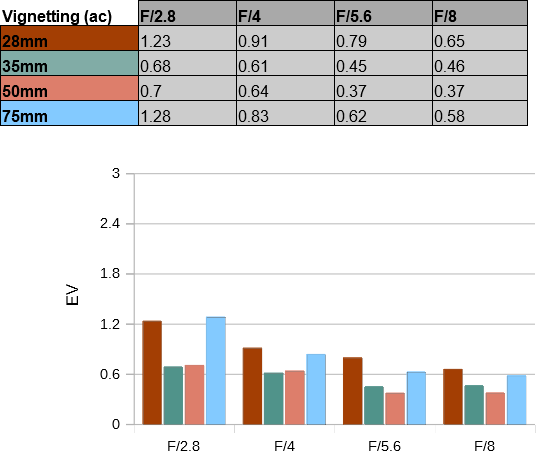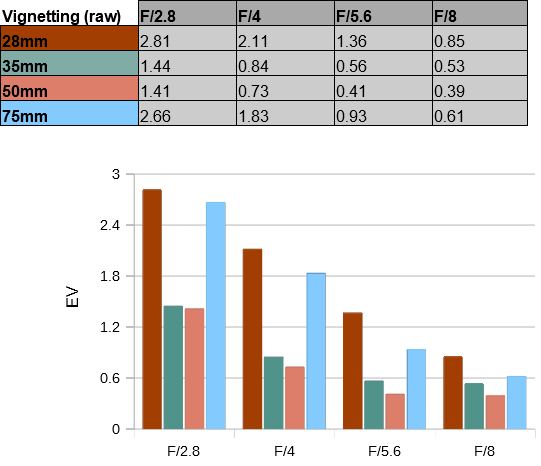|
Tamron 28-75mm f/2.8 Di III RXD - Review / Test Report - Analysis |
|
Lens Reviews -
Sony Alpha (Full Format)
|
|
Page 2 of 3

Distortion
With activated image auto-correction, you don't really have to worry about image distortions. They are near-zero as you can see below.
When looking at the RAW characteristic, the situation is slightly worse but still very acceptable for a standard zoom lens.
The lens shows a slight barrel distortion at 28mm and medium pincushion distortions at 75mm. In between the distortions are negligible.
Vignetting
In standard shooting mode - thus with activated image auto-correction - the vignetting is quite well controlled with a maximum of about 1.2EV (f-stops) at the extreme ends of the zoom range. This may be slightly visible in some scenes but if needed, just stop down a little bit. The light-falloff is comparatively low in the middle range.
 When looking at the RAW image, the native vignetting is much more obvious with a very heavy light falloff at the extreme ends. It reveals that the rather small diameter of the lens elements is taking its toll here. You have to stop down till at least f/5.6 till the issue is reasonably resolved at 28/75mm. The middle range is, once again, not quite as affected by this.
When looking at the RAW image, the native vignetting is much more obvious with a very heavy light falloff at the extreme ends. It reveals that the rather small diameter of the lens elements is taking its toll here. You have to stop down till at least f/5.6 till the issue is reasonably resolved at 28/75mm. The middle range is, once again, not quite as affected by this.

MTF (resolution at 42 megapixel)
While standard zoom lenses are certainly the most popular lens category they are also the most difficult to design - especially when it comes to large aperture variants. It doesn't matter whether it's about an expensive original manufacturer lens or a third-party offering - they all have their flaws. Thus, unsurprisingly, it's no different with the Tamron 28-75mm f/2.8 Di III RXD. Let's start with the most positive aspect - the broader center performance. Tamron managed to provide a superb quality here which exceeds most other lenses that we have tested on Sony E-mount to date. That's regardless of the zoom setting. However, the glory ends when looking at the image borders/corners. At 28mm they are quite soft at f/2.8 but they recover when stopping down. The border quality is decent from f/5.6 whereas you better stop down to f/8-11 for good corner quality. At 35mm the border quality improves whereas the corners remain soso at wide-open aperture. The 50mm setting is the sweet spot with a quite homogeneous performance for a zoom lens at least. The quality of the outer region drops again at 75mm with rather weak results at f/2.8 and fairly good from f/5.6 onward.
The field curvature is minimal. The centering quality of the tested sample was good.
Please note that the MTF results are not directly comparable across the different systems!
Below is a simplified summary of the formal findings. The chart shows line widths per picture height (LW/PH) which can be taken as a measure for sharpness.
If you want to know more about the MTF50 figures you may check out the corresponding Imatest Explanations

Chromatic Aberrations (CAs)
Once again - on Sony cameras, you don't really have to worry about chromatic aberrations due to image auto-correction. However, even if you prefer to disable this for whatever reason, the CAs are very low at around 0.6px on the average at the image borders.

Bokeh
When investing in a fast lens, you usually do so for shallow depth-of-field photography. Thus beyond the primary characteristics, the bokeh (rendition of the out-of-focus blur) is a major factor. To be honest - standard zoom lenses tend to struggle here due to the generous use of aspherical elements in the design - and the Tamron 28-75mm f/2.8 Di III RXD is no exception to the rule.
The background blur (shown to the left below) is about average for a lens in this class. High contrast transitions can be a little rough (e.g. the crown). The foreground blur is quite smooth.
 Highlights, well, they are not good at f/2.8. That is unless you like bubbles (there were Kickstarter campaigns where this was mentioned a feature actually ...). However, if you just stop down a little, the bubbles are actually gone. The inner zone of the highlight discs isn't totally clean but not too bad.
Highlights, well, they are not good at f/2.8. That is unless you like bubbles (there were Kickstarter campaigns where this was mentioned a feature actually ...). However, if you just stop down a little, the bubbles are actually gone. The inner zone of the highlight discs isn't totally clean but not too bad.
 The highlights are never getting any better to the image borders and combined with the bubbles at f/2.8, it can hurt a little ... However, once again - just stop down 2/3 f/stops and things are much better here as well.
The highlights are never getting any better to the image borders and combined with the bubbles at f/2.8, it can hurt a little ... However, once again - just stop down 2/3 f/stops and things are much better here as well.
 The shape of the outer "discs" changes when stopping down. Below is a visualization of this transition. Please note that this is completely normal to some degree. The "cat eyes" are a vignetting effect due to the limited diameter of the lens barrel.
The shape of the outer "discs" changes when stopping down. Below is a visualization of this transition. Please note that this is completely normal to some degree. The "cat eyes" are a vignetting effect due to the limited diameter of the lens barrel.
Bokeh Fringing / LoCA
Bokeh fringing describes chromatic aberration on the Z-axis with greenish halos beyond the focus point and purple halos in front. Typically this kind of fringing is visible on very fast lenses till about f/2.8. Below you may also spot fringing traces at this setting but they are mostly gone from f/4 (shown at 75mm).
|